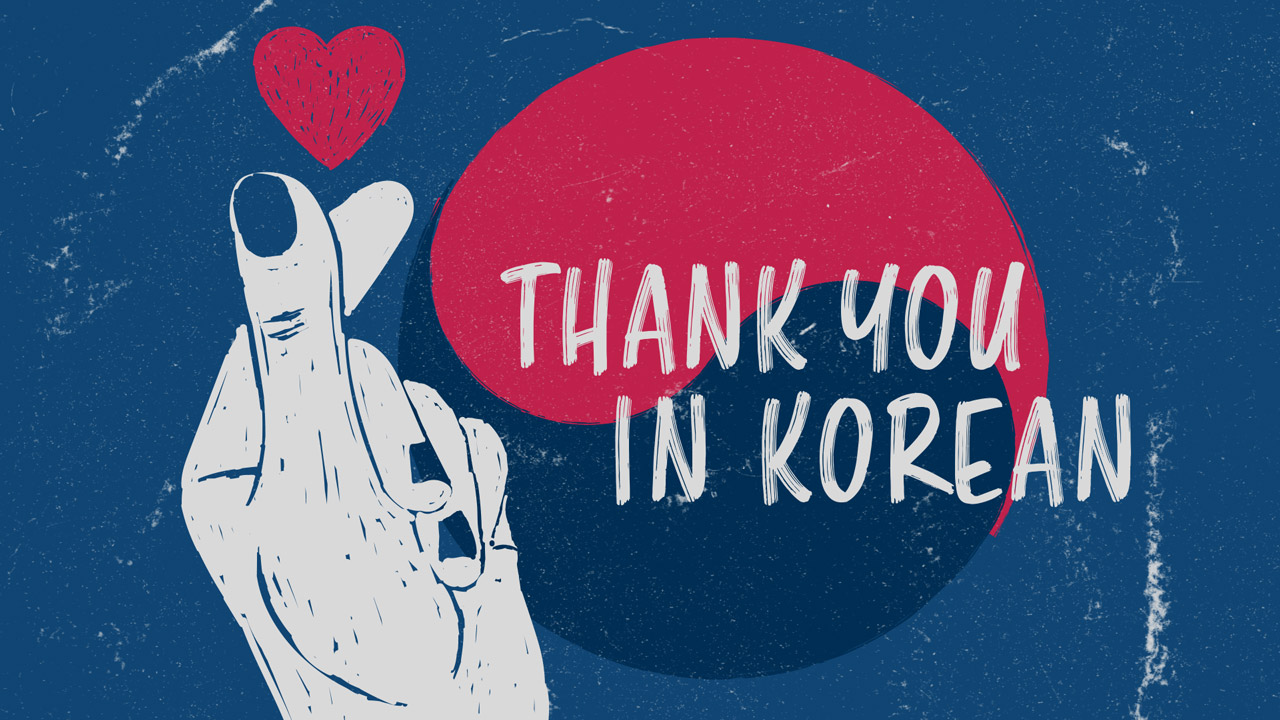Learn How to Say “Thank You” in Korean (Master Your Manners)
How do you say “thank you” in Korean? It’s 감사합니다 (gamsahamnida). Simple, right?
Well, not totally. “Thank you” in the Korean language actually depends on a thing called formality, due to the hierarchical nature of Korean culture.
So how to say “thank you” in Korean depends on who you’re talking to.
감사합니다 (gamsahamnida) is the most standard, safest bet in most situations as a beginner learning Korean.
There are also certain polite gestures that go with it.
So if you want to sound like a native and express gratitude in the best way possible, then keep reading.
Here’s what we’ll be learning:
- “Thank you” in Korean in formal, polite, and informal speech
- How to show your gratitude with body language
- Example sentences to express your thanks
- How to say “you’re welcome” in Korean
- How to politely decline or say “no, thank you” in Korean
- How to express your gratitude for food
- Korean slang and text shorthand for “thank you”
Now, let’s jump right in!
Thank You in Korean – 감사합니다
We already talked about 감사합니다 (gamsahamnida) means “thank you”, but let’s learn a bit more about it.
The Korean word for “thank you” comes from the verb 감사하다 (gamsahada), which combines gamsa (“thank” and “gratitude”) and hada (“to do”). So it means, “to thank” or “to do gratitude”.
It sounds a bit awkward like that, but it just means you show your appreciation.
You can use this phrase with anyone older than you, at a higher social status (like a boss), or strangers.
But you would not use this phrase with people you’re close to.
A note about the romanization of 감사합니다: Korean Hangul can be romanized a few ways, due to how some characters sound like two English letters.
Here, it could be gamsahamnida or kamsahamnida — because the first consonant, ㄱ, isn’t a harsh g or k. It often sounds in between the two.
The same is true for the end part of the phrase: 합니다. Even though ㅂ is typically romanized “b” or “p”, here it sounds like “m”, so it’s romanized that way.
Why? Because of the way the characters flow together, the “b” ends up not really being pronounced, and the “ha” and “ni” get smooshed together to sound like “hamni”.
I point this out because you’ll also see it romanized as gamsahabmnida.
That’s why it’s important to learn how to read Hangul, so you can master pronunciation!
Example: 시간 내 주셔서 감사합니다. Sigan nae jusyeoseo gamsahamnida. “Thank you for your time.”
While there are polite and informal ways to say this phrase, they’re not really used. Instead, you’ll use different variations of the next phrase:
Another Way to Say “Thank You” in Korean – 고맙습니다
You can also use 고맙습니다 (gomapseumnida) as “thank you” in Korean, and it’s almost interchangeable with 감사합니다 (gamsahamnida).
This version comes from the verb 고맙다 (gomapda), “to be grateful.”
It’s still quite polite, but this phrase is more acceptable to use with friends and family, as well as coworkers on the same level as you.
But there are other, less formal ways, you can show your thanks to people you’re familiar with and we’ll get to that next.
It doesn’t matter too much which one you use, to be honest. And most Koreans use them interchangeably. In the end, it comes down to personal preference which you use.
But you’ll hear both, so it’s good to know them!
Here are some sample sentences: 도와 주셔서 고맙습니다. Dowa jusyeoseo gomapseumnida. “Thank you for your help.”
양해 해 주셔서 고맙습니다. Yanghae hae jusyeoseo gomapseumnida. “Thank you for your patience/understanding.”
Yet Another Way How to Say “Thank You” in Korean – 고마워요
고마워요 (gomawoyo) is the Korean standard version of gomapseumnida. But, even though it’s less formal, it’s still polite… So it’s too formal for friends but too informal for strangers.
The phrase, then, gets used most often with people you know who are on the same level as you, but who you are not friends with, and need to still show some respect.
Think of coworkers here. Most of your coworkers on your team at work are of the same “level” as you (in roughly the same position and standing in the company). And you’re familiar, even a bit chatty sometimes.
You may go out for drinks after work together as a group, but you don’t really chat with any of them one-on-one outside of work.
That’s when you’d use 고마워요 (gomawoyo).
Example: 프로젝트를 도와 주셔서 고마워요. Peulojekteuleul dowa jusyeoseo gomawoyo “Thank you for helping with the project.”
By the way, you may notice most of the sentences I’ve used also use the phrase “dowa jusyeoseo” or “ jusyeoseo”.
That’s because 도와 (dowa) means “help” and 주셔서 (jusyeoseo) means “for”, as in to do something “for” someone else. So you’ll often see it used with “thank you.”
How to Say Thanks in Korean – 고마워
“Thanks” in Korean is 고마워 (gomawo). You may notice it’s very similar to the last phrase we learned – 고마워요 (gomawoyo). And that’s because it’s still a conjugation of 고맙다 (gomapda).
This phrase is informal, so you’ll want to use it with those you’re close to or anyone younger than you, but only if you know them. Even if they’re younger than you, or a child, but you don’t know them? Using informal speech will come off as rude.
So make sure you only use this phrase with friends and family — and even then, the situation may sometimes still call for 고마워요 (gomawoyo).
Example phrases: 네, 커피 가져와 주셔서 고마워! Ne, keopi gajyeowa jusyeoseo gomawo! “Thanks for bringing me coffee!”
청소를 도와 주셔서 고마워. Cheongsoleul dowa jusyeoseo gomawo. “Thanks for helping me clean.”
Say Thank You in Korean with Body Language!
It’s custom when saying thank you in Korea to bow. This is actually true with most greetings and polite phrases — you’d also bow when saying “hello” in Korean!
You’ll want to bow in relation to your social status and how grateful you are. Everything comes back to social status!
For example, thanking a friend needs only a slight bow of the head. But when it’s someone super important, like a Prime Minister or Queen, you would bow to almost a complete 90-degrees to say “thank you” in Korean formally.
If you do ever bow more formally, make sure to hinge from your hips so your back stays straight. Your hands stay by your side or rest on the front of your thighs.
Formal Way to Say “Thank You” in Korean
We already learned two ways to say “thank you” in Korean formal speech – 감사합니다 (gamsahamnida) and 고맙습니다 (gomapseumnida). But we can make it even more formal and express deeper gratitude if we need to.
대단히 감사합니다 (daedanhi gamsahamnida) means “thank you so much” and it’s saved for when you’re extremely grateful.
대단히 means “very” or “greatly”. It’s only used with 감사합니다 (gamsahamnida).
This is a humbling phrase and used when someone’s done you a big favor or sometimes with clients to say thanks for their patronage. But this isn’t a common phrase to hear.
So what is “thank you” in Korean formal speech that you would hear?
Usually, you’ll hear 정말 고맙습니다 (jeongmal gomapseumnida) instead. 정말 (jeongmal) means “really” or “truly.” So this means, “I’m truly grateful.”
How to Say Thanks in Korean – Informal Version
As I mentioned, 고마워 (gomawo) is the phrase you use with anyone who you’re on good terms with, of the same social status, or younger in age.
You can also change up these phrases with words like 정말 (jeongmal, “really”), 진짜 (jinjja, “really” as well), and 너무 (neomu, “too much, exceedingly”).
Examples: 정말고마워! Jeongmal gomawo! “Thanks so much!”
저녁을 요리 해주셔서 진짜고마워! Jeonyeokeul yoli haejusyeoseo jinjja gomawo! “Thanks so much for cooking dinner!”
칭찬 해주셔서 너무고마워. Chingchan haejusyeoseo neomu gomawo. “Thanks so much for the compliment.”
You’re Welcome in Korean – 아니에요
There are three main ways to say “you’re welcome” in Korean. Let’s start with the most common one, which is 아니에요 (anieyo).
아니에요 (anieyo) actually translates as “no” or “not at all,” but it’s used to mean something like “don’t mention it.”
It’s common to be humble and not expect praise or thanks in Korean culture, so this is the most common response. It’s formal version, though, is 아닙니다 (animnida) and informal is 아니야 (aniya).
The second polite way to say “you’re welcome” is 괜찮아요 (gwaenchanayo) which means “it’s okay.” (There are a lot of uses for this phrase though!) Informally, it’s 괜찮아 (gwaenchana).
You’ll often hear these two phrases said together, especially in Korean dramas. “아니야, 괜찮아.” (Aniyo, gwaenchana) “No, it’s okay, it was nothing.”
There are two formal ways to say “you’re welcome” in Korean, but neither are said often in spoken language. You’ll mostly see these in writing.
They are:
- 천만에요 (cheonmaneyo)
- 별말씀을요 (byeolmalsseumeulyo)
The first is usually what you’ll find for the direct translation of “you’re welcome” from a Korean dictionary. And the second means “don’t mention it”… but in a very formal way.
Politely Refusing in Korean – “No, thank you”
“No thank you” in Korean is actually the same as “you’re welcome!” You can use 아니에요 (anieyo, “no”) or 괜찮아요 (gwaenchanayo, “it’s okay”), or say them together.
It’s not very polite to outright refuse by only saying “no”, so it’s best to say “that’s okay” instead.
“Thank You For the Food” in Korean
There are quite a few phrases related to food and expressing care, concern, and gratitude.
For instance, you can greet someone with 밥 먹었어요? (bab meogeosseoyo) which means “Did you eat?” It’s an affectionate way to ask “how are you?” and make sure they’re taking care of themselves.
Let’s say your mom has you over for dinner. She’ll ask you 밥 먹었어요? (bab meogeosseoyo), to which you’ll reply, 아니야 (aniyo), because obviously, you want that good home cooked food.
So your mom makes dinner, and she’ll present it and say something like 자 들어요 (ja deuleoyo) which is informally something like “let’s eat.”
Although in formal situations (like if she was serving guests) she’d say 많이 드세요 (manhideuseyo), which means “bon appetit” or “eat a lot”.
Likewise, before you eat, you’ll say 잘 먹겠습니다 (jal meokgetseumnida) which means something like “I will eat well (thanks to you)”.
And after you’re done eating, you’ll say 잘 먹었습니다 (jal meogeotseumnida) which means “thanks for this meal,” although it’s literal meaning is “I’ve had enough / I ate well.”
In Korea, you should wait for the oldest person (or highest status) to eat before you begin eating.
But note that this is a bit formal and many Koreans don’t stick to these rules (or even formal phrases) anymore.
They’re still good to know though, especially to be polite in formal situations or where you’re a guest in someone else’s home.
Korean Slang and Text Shorthand for “Thank You” in Korean
Sometimes, Korean will say the English “thank you” in Korean — it’s 땡큐 (ttaengkyu).
You can also say 감사 (gamsa), the shortened form of gamsahamnida) to say “thank you” in Korean.
In text, you’ll see this shortened even more. Like in English where we send the first letter of each word – “ty” – Koreans do the same thing.
So, when you receive a text that says ㄱ ㅅ, it’s short for gamsahamnida.
Gomawoyo for Your Time! Let’s Wrap It Up.
Whew! We learned a lot today, especially about formalities when it comes to saying “thank you.” Not as simple as you first thought, huh?
Here’s a recap:
- “Thank you” (formal) – 감사합니다 (gamsahamnida)
- “Thank you” (formal, but slightly less so) – 고맙습니다 (gomapseumnida)
- “Thank you” (polite) – 고마워요 (gomawoyo)
- “Thank you” (informal) – 고마워 (gomawo)
- “Thank you very much” (formal) – 대단히 감사합니다 (daedanhi gamsahamnida)
- “Thank you very much” (polite) – 정말 고맙습니다 (jeongmal gomapseumnida)
- “Thank you very much” (informal) – 정말고마워! (jeongmal gomawo!)
- “You’re welcome” (formal) – 천만에요 (cheonmaneyo)
- “Not at all” / “Don’t mention it” (informal) – “아니야, 괜찮아.” (aniyo, gwaenchana)
- “No, thank you” (polite) – 아니에요, 괜찮아요 (anieyo, gwaenchanayo)
- “I will eat well (thanks to you)” – 잘 먹겠습니다 (jal meokgetseumnida)
- “Thank you for this food” – 잘 먹었습니다 (jal meogeotseumnida)
- “Thanks” (slang) – 감사 (gamsa)
- “Ty” (text shorthand) – ㄱ ㅅ (g s)
You’ve mastered your manners in Korean! Now take your next steps by learning Korean numbers, or how to talk about colors in Korean.
파이팅! (paiting!, Cheers!)









Social